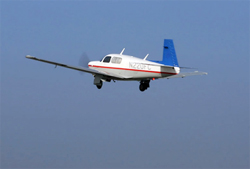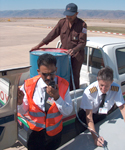 CarolAnn Garratt and copilot Carol Foy leave San Diego Brown Field. Photo courtesy of ALS World Flight.
CarolAnn Garratt and copilot Carol Foy leave San Diego Brown Field. Photo courtesy of ALS World Flight.
Eighteen months of planning paid off for CarolAnn Garratt Dec. 11 after she and copilot Carol Foy completed their seven-day, 160-hour round-the-world flight in a Mooney to raise money and awareness for Amyotrophic Lateral Sclerosis (ALS), also known as Lou Gehrig’s disease. Garratt’s mother died of ALS in 2002.
Upon final touchdown in Orlando, the two set an unofficial world record. The National Aeronautic Association is reviewing the record attempt and will then send the information to the Federation Aeronautique Internationale, the governing body for world records. Final approval is expected within 90 days.
“The better the planning, the better the execution,” Garratt told AOPA. She started searching for a copilot in May 2007 and remembered Foy, a fellow Mooney owner she had met three years earlier at Oshkosh, Wis. Foy, who participates in air races and ferries Mooneys, talked to Garratt on the phone and via e-mail before accepting the position.
But, as Garratt later learned, the mission would be important to Foy for multiple reasons. Not only did she love flying Mooneys, she also has a family member who was diagnosed with ALS in 2007.
“It’s such a debilitating disease,” Garratt said.
ALS is a motor neuron disease that typically strikes people between the ages of 40 and 70, causing brain and spinal cord degeneration that leads to muscle atrophy. The cause of the disease that affects nearly 30,000 Americans (about 15 new cases daily) is not yet fully understood, according to the ALS Association. Nearly half of those with ALS live three to five years after diagnosis, 20 percent five or more years, and 10 percent more than 10 years. ALS first received widespread attention in the late 1930s when baseball star Lou Gehrig was diagnosed with the disease.
 CarolAnn Garratt (right) and copilot Carol Foy in Hawaii. Photo courtesy of ALS World Flight.
CarolAnn Garratt (right) and copilot Carol Foy in Hawaii. Photo courtesy of ALS World Flight.
In an effort to raise money for ALS research, Garratt and Foy spent about seven months giving presentations across the country. They paid 100 percent of the expenses related to the trip out of their own pockets, so that all of the donated money could go toward ALS research. Even though company after company in the aviation industry rejected opportunities to help sponsor the flight or donate to the cause, the pilot community came together to help them raise $153,209 of their $1 million goal for ALS.
Garratt and Foy flew together a few times on test and training flights to get acquainted with each other and practice for the trip, including making some over-gross takeoffs. They even conducted a two-day flight, with an overnight stop, so that they could experience some of the fatigue they would on the trip, among other things. During the seven-day trip, they would have to eat, sleep, and relieve themselves in the airplane, which takes some practice.
“You can’t just do one of these things at the drop of a hat,” Garratt explained. Garret should know. She flew around the world in 2003, also to raise money for ALS research.
She gathered the necessary charts—most of which were for crossing the United States, as she needed only eight for the rest of the route, plus arrival and approach procedures for each of the stops along the way.
 Garratt refuels using a 55-gallon drum and hand crank. Photo courtesy of ALS World Flight.
Garratt refuels using a 55-gallon drum and hand crank. Photo courtesy of ALS World Flight.
The trip took them from Orlando to San Diego; Lihue, Hawaii; Guam; Bangkok, Thailand; Salalah, Oman; Djibouti; Bamako, Mali; Cape Verde Islands; and back to Orlando.
Because Garratt prepared in advance and received prior approval for the routes and airways she planned to fly in the various countries, she had no delays getting through. The only hiccup came as they crossed the African continent.
“Stops in Africa have been interesting, especially the refueling process. Fuel has come in 55 gallon drums on the back of a truck and must be hand cranked to get it into the airplane. Each fill up, at Salalah, Djibouti, and in Ouagadougou was accomplished by airport staff, even at 2 a.m.,” the two wrote in a flight log update.
During the trip, the two alternated left and right seat each leg and took turns sleeping every two hours.
 CarolAnn Garratt (right) and copilot Carol Foy leaving Hawaii. Photo courtesy of ALS World Flight.
CarolAnn Garratt (right) and copilot Carol Foy leaving Hawaii. Photo courtesy of ALS World Flight.
The Mooney, which Garratt flew around the world in 2003, performed flawlessly on the trip: “Not one thing broke in 160 hours.” She and her mechanic worked tirelessly before the trip to make sure the aircraft was in top condition.
“It’s been around twice, and it’s got another one in it,” Garratt said, explaining that she plans to make one more trip around the world, although not at the same record-breaking pace.
[Note: Garratt will release a book in February about her latest trip, called “ Upon Silver Wings: World Record Adventure.” All of the proceeds from the sale will go to the ALS Therapy Development Institute.]
